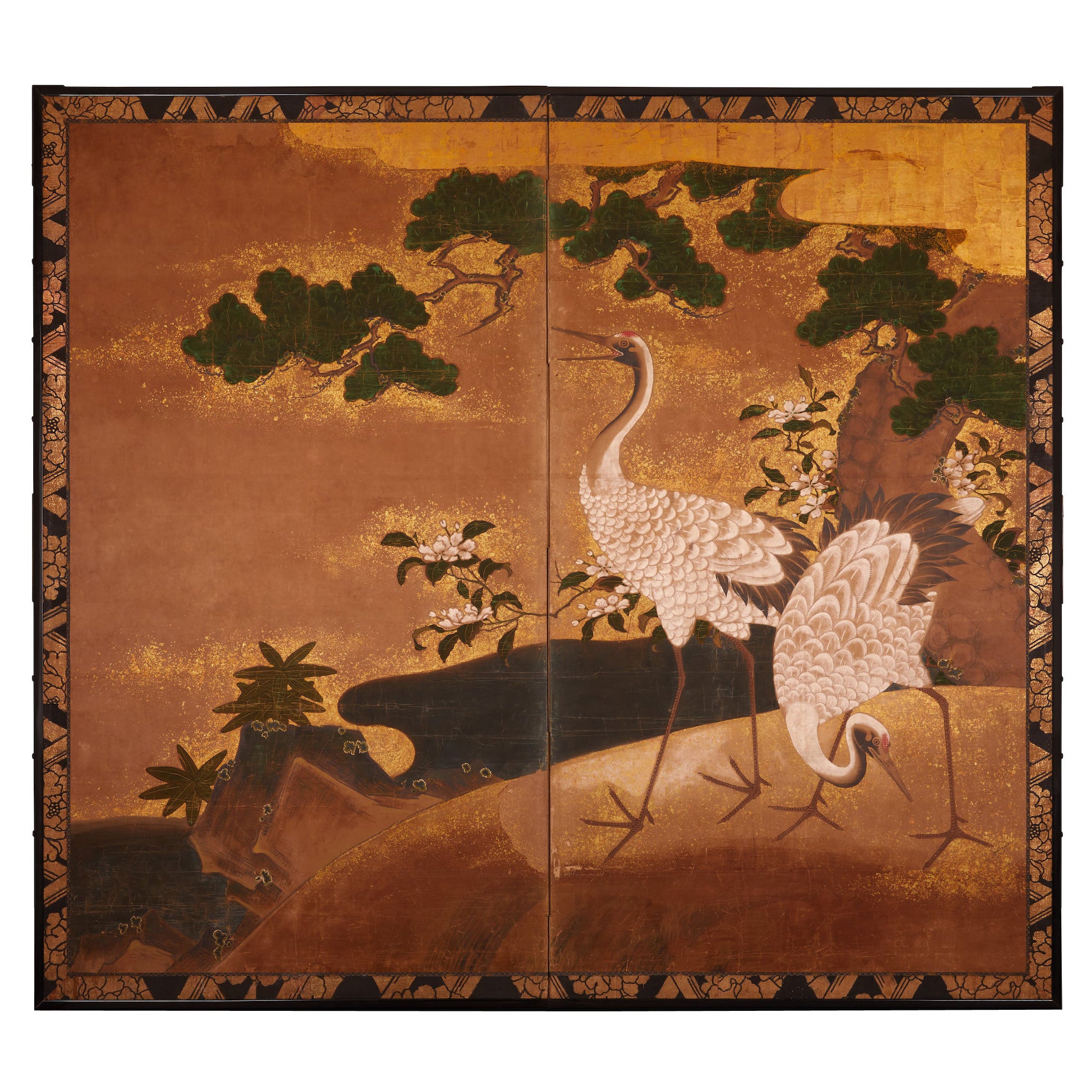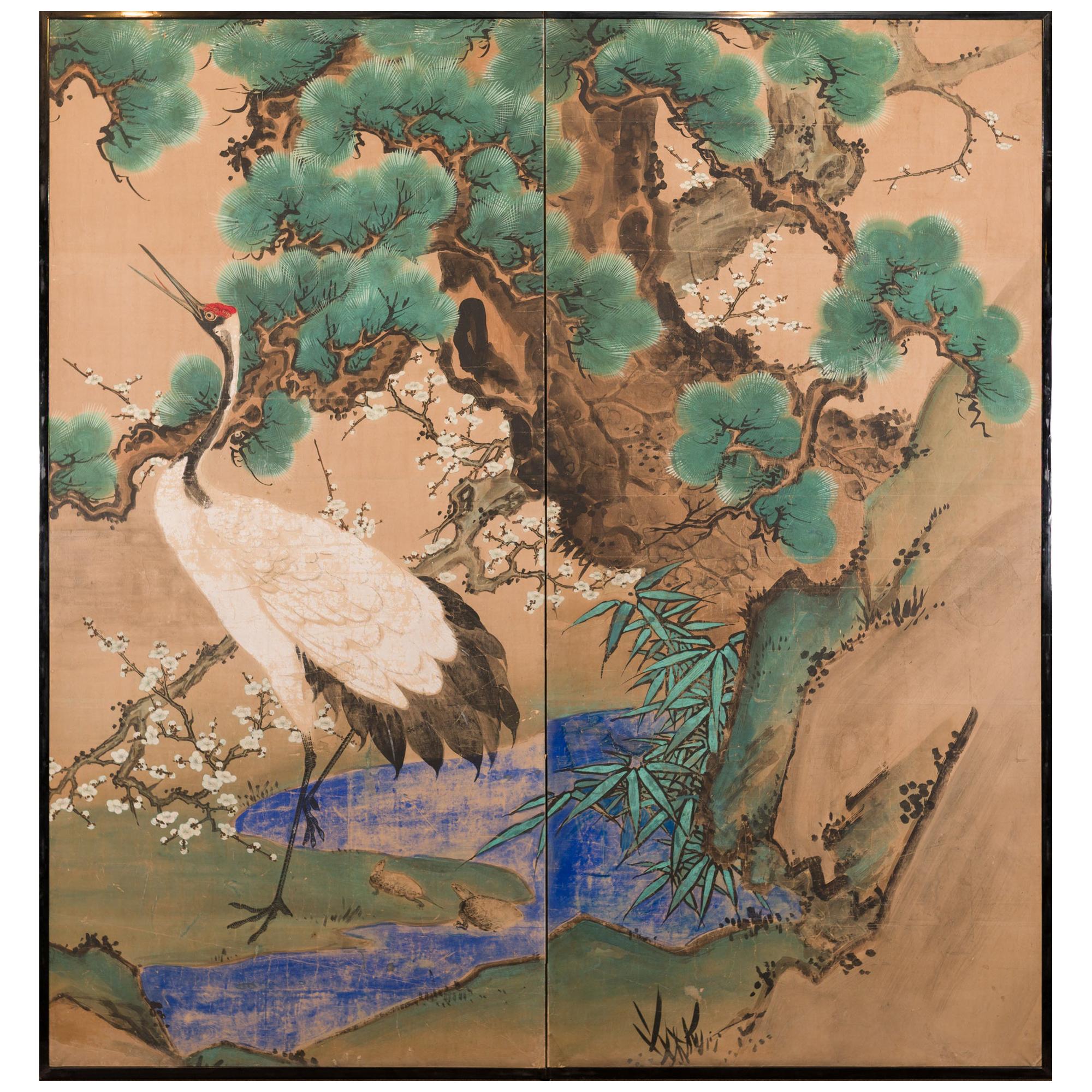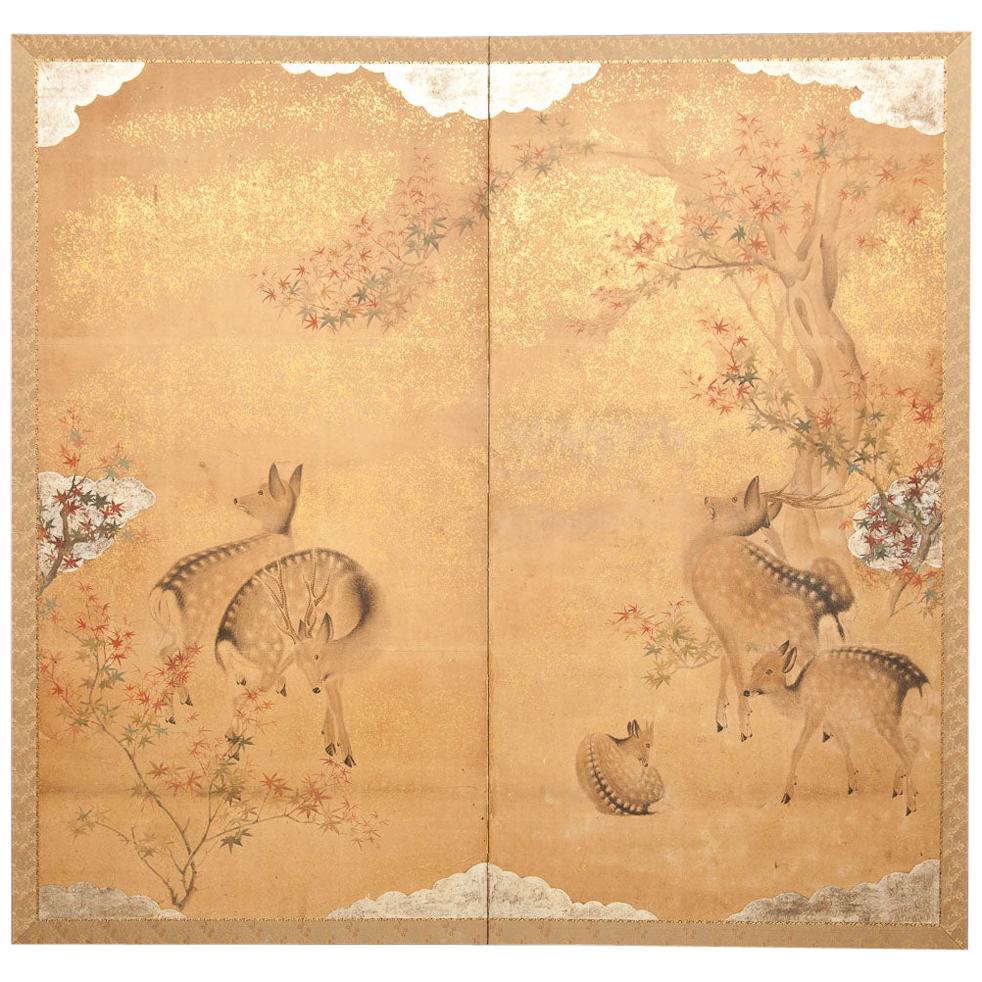Items Similar to Japanese Two Panel Screen Sedge of Cranes in Rolling Landscape with Gold Clouds
Want more images or videos?
Request additional images or videos from the seller
1 of 14
Japanese Two Panel Screen Sedge of Cranes in Rolling Landscape with Gold Clouds
About the Item
Meiji period (1868-1912) painting of a group of cranes gathering next to water's edge with gold dust clouds in the background. The scene is accented by wild grasses and lichen on the rock formation. Painted in mineral pigments on mulberry paper with gold dust. Mounted with a beautiful 19th century brocade with a bamboo motif and a black gloss lacquer frame. On the reverse is handmade backing paper with family crests in gold.
- Dimensions:Height: 67.38 in (171.15 cm)Width: 68 in (172.72 cm)Depth: 0.75 in (1.91 cm)
- Style:Meiji (Of the Period)
- Materials and Techniques:
- Place of Origin:
- Period:
- Date of Manufacture:circa 1880-1890
- Condition:Most items that are 100 years old have been cleaned or polished in their lifetime. More involved restorations are mentioned in the above description. For a detailed condition report and a video of this item please contact us directly. -Naga Antiques.
- Seller Location:Hudson, NY
- Reference Number:
About the Seller
5.0
Recognized Seller
These prestigious sellers are industry leaders and represent the highest echelon for item quality and design.
Established in 1971
1stDibs seller since 2008
149 sales on 1stDibs
Typical response time: 8 hours
Associations
The Art and Antique Dealers League of AmericaAntiques Associations Members
- ShippingRetrieving quote...Ships From: Hudson, NY
- Return PolicyThis item cannot be returned.
More From This SellerView All
- Japanese Two-Panel Screen: Cranes on GoldLocated in Hudson, NYEarly Kano School painting of pine trees overlooking two beautifully painted cranes and floral design in a natural setting by water’s edge. Mineral pig...Category
Antique Late 18th Century Japanese Paintings and Screens
MaterialsGold, Gold Leaf
- Japanese Two Panel Screen Sun Over Floral Landscape with Gold CloudsLocated in Hudson, NYMineral pigments on mulberry paper and gold leaf.Category
Antique Late 19th Century Japanese Paintings and Screens
MaterialsPaper
- Japanese Six Panel Screen: Rolling Country LandscapeLocated in Hudson, NYA mid-sized six panel screen. Edo period (c. 1800) painting of a landscape features a temple on the mountain top, a river with fishermen emerging from gold...Category
Antique Early 19th Century Japanese Edo Paintings and Screens
MaterialsGold Leaf
- Japanese Two Panel Screen Manchurian Crane and TurtlesLocated in Hudson, NYIn Japan, cranes symbolize fidelity as they mate for life and turtles symbolize longevity. Additionally, this screen also has the Japanese motif of sho-chiku-bai, or the three friends of winter (pine, plum, and bamboo). So called the three friends of winter because all three flourish during the cold months. This screen was originally fusuma doors...Category
Antique Mid-19th Century Japanese Edo Paintings and Screens
MaterialsPaper
- Japanese Two Panel Screen Amorous Cranes and TurtlesLocated in Hudson, NYJapanese two panel screen: Amorous Cranes and Turtles. In Japan, cranes symbolize fidelity as they mate for life and turtles symbolize longevity. Additionally, this screen also has the Japanese motif of sho-chiku-bai, or the three friends of winter (pine, plum, and bamboo). So called the three friends of winter because all three flourish during the cold months. This screen was originally fusuma doors...Category
Antique 1850s Japanese Edo Paintings and Screens
MaterialsWood, Paper
- Japanese Two Panel Screen Nara Deer in Gentle Yoshino LandscapeLocated in Hudson, NYJapanese two panel screen: Nara Deer in Gentle Yoshino Landscape. Yoshino is in the Nara Prefecture, an area famous for these small and tame deer native to J...Category
Antique Early 1900s Japanese Meiji Paintings and Screens
MaterialsGold Leaf, Silver Leaf
You May Also Like
- Japanese Two-Panel Gold Leaf Screen by YoshikawaLocated in Rio Vista, CAStunning Japanese two-panel folding screen featuring a gold leaf landscape signed by Yoshikawa. Delicate scene of cherry and willow trees near a village with high mountains in the ba...Category
20th Century Chinese Meiji Paintings and Screens
MaterialsBrass, Gold Leaf
- Japanese Meiji Two Panel Screen Song Birds in SakuraLocated in Rio Vista, CAExceptional Japanese Meiji period two-panel screen, circa 1900. Featuring songbirds amid sakura cherry trees and flowering peony. Made in the Nihonga School style on handcrafted mulb...Category
20th Century Japanese Meiji Paintings and Screens
MaterialsBrass
- Pair of Japanese Meiji Six Panel Screens of Seasonal LandscapesLocated in Rio Vista, CAFascinating pair of large Japanese Meiji period six-panel screens of seasonal landscapes with flowers and birds. The first screen depicts a pair of pheasants in a spring landscape with a white flowering cherry tree, peonies, and rose of Sharon with brush clover. The second screen depicts a pair of quail in an autumn landscape with flowering autumn plants and grasses including chrysanthemums, bellflowers, and ominaeshi. The umbrella pines appear to be in the manner of Kano Tanyu...Category
Antique 19th Century Japanese Meiji Paintings and Screens
MaterialsBrass, Gold Leaf
- Japanese Four-Panel Rimpa Screen Floral Autumn LandscapeLocated in Rio Vista, CAMagnificent Japanese four-panel 19th century Meiji screen. Made in the Rimpa School style depicting a serene floral autumn landscape. Beautifully painted sumi ink and color pigments ...Category
Antique 19th Century Japanese Meiji Paintings and Screens
MaterialsBrass, Gold Leaf, Silver Leaf
- Japanese Six Panel Kano School Winter Landscape ScreenLocated in Rio Vista, CALarge Japanese Meiji period six-panel screen depicting a winter landscape with a Chinese sage visiting friends in a country villa. Ink and vivid color pigments on mulberry paper mounted to a gilt background. Painted in the 19th century Kano school...Category
Antique 19th Century Japanese Meiji Paintings and Screens
MaterialsMetal
- Japanese Meiji Two Panel Screen Geese and ReedsLocated in Rio Vista, CAFantastic Japanese late Meiji period two-panel byobu screen by Hashimoto Koshu. The large screen features two white geese amid brightly colored reeds. The symbolism of geese and reeds was introduced to Japan from China in the 13th century. This was a popular subject for Japanese zen artists of the period. Beautifully crafted with exceptional brush strokes and details. Made with natural pigments in dramatic vivid colors of white, pink, and mint green on a silk background of gilt. Circa 1900 with artist seal on bottom right corner. Koshu studied Western art under...Category
20th Century Japanese Meiji Paintings and Screens
MaterialsSilk, Wood, Paper
Recently Viewed
View AllMore Ways To Browse
Gold Dust
Antique Clouds
Bamboo Motif
Antique Family Crest
Japanese Screen Black
Japan Clouds
Japanese Clouds
Asian Framed Gold
Panel Screens In Gold
Hand Painted Silk Screen
Japanese Landscape Screen
Japan Crane
Japanese Crane
Cranes Japan
Asian Black Screens
Asian Cranes
Japanese Landscapes Screen And Paintings
Japanese Screen Gold On Gold





